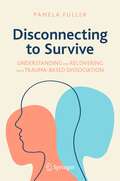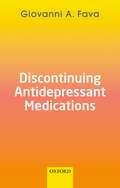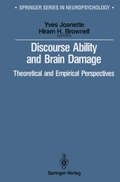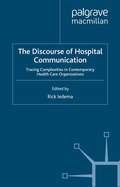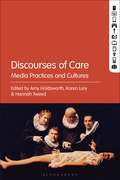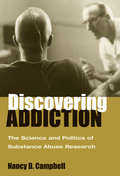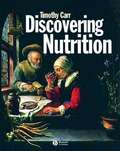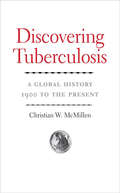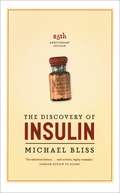- Table View
- List View
Disconnecting to Survive: Understanding and Recovering from Trauma-based Dissociation (Copernicus Books)
by Pamela FullerThis book provides up-to-date guidance on how to recognize and reduce trauma-based dissociation. Through a therapist-guided approach, readers will increase their awareness of their own experiences of dissociation and develop strategies for reducing these responses, with an overall goal of feeling more connected within themselves and with others. Trauma-based dissociation usually first occurs during a very threatening situation from which there is no physical escape. The dissociative response happens automatically for protection outside of awareness, so the person doesn’t realize what they were doing. This protective response can happen again when other concerning situations occur, and eventually develop into an automatic response to perceived threats. Disconnecting to Survive: Understanding and Recovering from Trauma-based Dissociation is a guide for individuals who experience dissociation or wonder if they do, and for their family, friends, and professionals who want to help them. Several unique features of this book make it valuable as a therapeutic experience for trauma survivors as well as a useful resource for professionals. "Check-ins” throughout the book provide an in-the-moment experience of self-monitoring and pacing while reading. Frequent case examples enhance understanding of the ideas described and validate the experiences of readers who have persevered through traumatic life situations. A section at the end of each chapter provides opportunity to explore how the concepts apply to the reader. Readers also will learn about a three-phase model for determining their present needs and their readiness for different interventions based on their phase of trauma recovery. In addition to physical, emotional, and sexual abuse, other types of interpersonal trauma are delineated, including race-based trauma, religious trauma, medical trauma, emotional neglect, military-related trauma, and mistreatment due to sexual orientation. In addition, a chapter is devoted to each of the important topics of dissociation in children and the relationship between trauma, dissociation, and psychosis.
Discontinuing Antidepressant Medications
by Giovanni A. FavaOne in six people in the US are currently taking psychotropic drugs. In 80% of cases, the medication is taken for long-term use and predominantly involves new-generation antidepressants, such as SSRIs (e.g. paroxetine) and SNRIs (e.g. venlafaxine). When patients want to stop taking these drugs and/or their physicians decide it is time for them to stop, substantial problems often can ensue. About 50% of patients experience withdrawal symptoms that do not necessarily subside after a few days or weeks and may be severe and debilitating. Physicians often do not know what to do in these situations. As a result, patients experiencing the anguish and mental pain of withdrawal syndromes are unlikely to receive appropriate medical attention. Discontinuing antidepressants is a highly technical challenge that requires specific strategies. This handbook guides clinicians through each clinical step (assessment; what the counter-indications would be for stopping or continuing; and how discontinuation can best be achieved). It provides a detailed account of the assessment and management strategies, with many case illustrations and clinical examples, drawing from the literature that is available and the extensive personal experience of the author.
Discontinuing Antidepressant Medications
by Giovanni A. FavaOne in six people in the US are currently taking psychotropic drugs. In 80% of cases, the medication is taken for long-term use and predominantly involves new-generation antidepressants, such as SSRIs (e.g. paroxetine) and SNRIs (e.g. venlafaxine). When patients want to stop taking these drugs and/or their physicians decide it is time for them to stop, substantial problems often can ensue. About 50% of patients experience withdrawal symptoms that do not necessarily subside after a few days or weeks and may be severe and debilitating. Physicians often do not know what to do in these situations. As a result, patients experiencing the anguish and mental pain of withdrawal syndromes are unlikely to receive appropriate medical attention. Discontinuing antidepressants is a highly technical challenge that requires specific strategies. This handbook guides clinicians through each clinical step (assessment; what the counter-indications would be for stopping or continuing; and how discontinuation can best be achieved). It provides a detailed account of the assessment and management strategies, with many case illustrations and clinical examples, drawing from the literature that is available and the extensive personal experience of the author.
Discourse Ability and Brain Damage: Theoretical and Empirical Perspectives (Springer Series in Neuropsychology)
by Hiram H. Brownell YvesJoanetteNonspecialists are often surprised by the issues studied and the perspectives assumed by basic scientific researchers. Nowhere has the surprise traditionally been greater than in the field of psychology. College students anticipate that their psychology courses will illuminate their personal problems and their friends' per sonalities; they are nonplussed to discover that the perception of geometric forms and the running ofT-mazes dominates the textbooks. The situation is comparable in the domain of linguistics. Nonprofessional observers assume that linguists study exotic languages, that when they choose to focus on their own language, they will examine the meanings of utterances and the uses to which language is put. Such onlookers are taken aback to learn that the learning of remote languages is a marginal activity for most linguists; they are equally amazed to discover that the lion's share of work in the discipline focuses on issues of syntax and phonol ogy, which are virtually invisible to the speaker of a language. Science moves in its own, often mysterious ways, and there are perfectly good reasons why experimental psychologists prefer to look at mazes rather than at madness, and why linguists study syntax rather than Sanskrit. Nonetheless, it is a happy event for all concerned when the interests of professionals and non specialists begin to move toward one another and a field of study comes to address the "big questions" as well as the experimentally most tractable ones. Discourse Ability and Brain Damage reflects this trend in scientific research.
The Discourse of Hospital Communication: Tracing Complexities in Contemporary Health Organizations (Communicating in Professions and Organizations)
by R. IedemaBringing together recent international research in the field of hospital communication and interaction, the contributors to this book contextualize clinical professional work by focussing on the rising intensity of information and communication practices in organizations generally, and in health care in particular.
The Discourse of Sensibility: The Knowing Body in the Enlightenment (Studies in History and Philosophy of Science #35)
by Henry Martyn LloydThis volume reconstructs the body of sensibility and the discourse which constructed it. The discourse of sensibility was deployed very widely throughout the mid- to late-eighteenth century, particularly in France and Britain. To inquire into the body of sensibility is then necessarily to enter into an interdisciplinary space and so to invite the plurality of methodological approaches which this collection exemplifies. The chapters collected here draw together the histories of literature and aesthetics, metaphysics and epistemology, moral theory, medicine, and cultural history. Together, they contribute to four major themes: First, the collection reconstructs various modes by which the sympathetic subject was construed or scripted, including through the theatre, poetry, literature, and medical and philosophical treaties. It secondly draws out those techniques of affective pedagogy which were implied by the medicalisation of the knowing body, and thirdly highlights the manner in which the body of sensibility was constructed as simultaneously particular and universal. Finally, it illustrates the ‘centrifugal forces’ at play within the discourse, and the anxiety which often accompanied them.At the centre of eighteenth-century thought was a very particular object: the body of sensibility, the Enlightenment’s knowing body. The persona of the knowledge-seeker was constructed by drawing together mind and matter, thought and feeling. And so where the Enlightenment thinker is generally associated with reason, truth-telling, and social and political reform, the Enlightenment is also known for its valorisation of emotion. During the period, intellectual pursuits were envisioned as having a distinctly embodied and emotional aspect. The body of ‘sensibility’ encompassed these apparently disparate strands and was associated with terms including ‘sentimental’, ‘sentiment’, ‘sense’, ‘sensation’, and ‘sympathy’.
Discourses of Care: Media Practices and Cultures
by Karen Lury Amy Holdsworth Hannah Tweed DiscoursesBringing together scholars from film and television studies, media and cultural studies, literary studies, medical humanities, and disability studies, Discourses of Care collectively examines how the analysis of media texts and practices can contribute to scholarship on and understandings of health and social care, and how existing research focusing on the ethics of care can inform our understanding of media.Featuring a critical introductory essay and 13 specially commissioned original chapters, this is the first edited collection to address the relationship between media and the concept and practice of care and caregiving. Contributors consider the representation of care and caregiving through a range of forms and practices – the television documentary, photography, film, non-theatrical cinema, tabloid media, autobiography, and public service broadcasting - and engage with the labour, as well as the practical and ethical dimensions of media production. Together, they offer an original and wide ranging exploration of the various ways in which media forms represent, articulate and operate within caring relationships and practices of care; whether this is between individuals, communities as well as audiences and institutions.
Discourses of Care: Media Practices and Cultures
Bringing together scholars from film and television studies, media and cultural studies, literary studies, medical humanities, and disability studies, Discourses of Care collectively examines how the analysis of media texts and practices can contribute to scholarship on and understandings of health and social care, and how existing research focusing on the ethics of care can inform our understanding of media.Featuring a critical introductory essay and 13 specially commissioned original chapters, this is the first edited collection to address the relationship between media and the concept and practice of care and caregiving. Contributors consider the representation of care and caregiving through a range of forms and practices – the television documentary, photography, film, non-theatrical cinema, tabloid media, autobiography, and public service broadcasting - and engage with the labour, as well as the practical and ethical dimensions of media production. Together, they offer an original and wide ranging exploration of the various ways in which media forms represent, articulate and operate within caring relationships and practices of care; whether this is between individuals, communities as well as audiences and institutions.
Discoveries in the Human Brain: Neuroscience Prehistory, Brain Structure, and Function
by Louise H. Marshall Horace W. Magoun170u can climb back up a stream of radiance to the sky, and back through history up the stream of time. 1 -Robert Frost topics that he judged to be important in brain his From the last years of the second millennium, tory leading into the end of the century, and was we can look back on antecedent events in neuro undertaken in response to the enthusiasm gener science with amazement that so much of modern ated by exhibition at several national and interna biomedical science was anticipated, or even said or done, in an earlier time. That surprise can be tional meetings of a series oflarge posters for which matched by appreciation for what the pioneer Magoun wrote a 27-page brochure. The posters investigators, with no inkling that they were creat were viewed by a multitude of young neuroscien ing a discipline, contributed to its emergence as a tists who wanted more, as well as by mature inves productive force in human progress. In today's tigators who were warmly pleased to see familiar names and faces from the past. The acclaim was reductionist atmosphere, in which research at the molecular level is producing breathtaking new accompanied by a veritable deluge of requests for knowledge throughout biology, the student may an illustrated, expanded publication.
Discovering Addiction: The Science and Politics of Substance Abuse Research
by Nancy D. CampbellDiscovering Addiction brings the history of human and animal experimentation in addiction science into the present with a wealth of archival research and dozens of oral-history interviews with addiction researchers. Professor Campbell examines the birth of addiction science---the National Academy of Sciences's project to find a pharmacological fix for narcotics addiction in the late 1930s---and then explores the human and primate experimentation involved in the succeeding studies of the "opium problem," revealing how addiction science became "brain science" by the 1990s. Psychoactive drugs have always had multiple personalities---some cause social problems; others solve them---and the study of these drugs involves similar contradictions. Discovering Addiction enriches discussions of bioethics by exploring controversial topics, including the federal prison research that took place in the 1970s---a still unresolved debate that continues to divide the research community---and the effect of new rules regarding informed consent and the calculus of risk and benefit. This fascinating volume is both an informative history and a thought-provoking guide that asks whether it is possible to differentiate between ethical and unethical research by looking closely at how science is made. Nancy D. Campbell is Associate Professor of Science and Technology Studies at Rensselaer Polytechnic Institute and the author of Using Women: Gender, Drug Policy, and Social Justice. "Compelling and original, lively and engaging---Discovering Addiction opens up new ways of thinking about drug policy as well as the historical discourses of addiction." ---Carol Stabile, University of Wisconsin--Milwaukee Also available: Student Bodies: The Influence of Student Health Services in American Society and Medicine, by Heather Munro Prescott Illness and the Limits of Expression, by Kathlyn Conway White Coat, Clenched Fist: The Political Education of an American Physician, by Fitzhugh Mullan
Discovering and Developing Molecules with Optimal Drug-Like Properties (AAPS Advances in the Pharmaceutical Sciences Series #15)
by Allen C Templeton Stephen R. Byrn Roy J Haskell Thomas E. PrisinzanoThis authoritative volume provides a contemporary view on the latest research in molecules with optimal drug-like properties. It is a valuable source to access current best practices as well as new research techniques and strategies. Written by leading scientists in their fields, the text consists of fourteen chapters with an underlying theme of early collaborative opportunities between pharmaceutical and discovery sciences. The book explores the practical realities of performing physical pharmaceutical and biopharmaceutical research in the context of drug discovery with short timelines and low compound availability. Chapters cover strategies and tactics to enable discovery as well as predictive approaches to establish, understand and communicate risks in early development. It also examines the detection, characterization, and assessment of risks on the solid state properties of advanced discovery and early development candidates, highlighting the link between solid state properties and critical development parameters such as solubility and stability. Final chapters center on techniques to improve molecular solubilization and prevent precipitation, with particularly emphasis on linking physiochemical properties of molecules to formulation selection in preclinical and clinical settings.
Discovering Biomolecular Mechanisms with Computational Biology (Molecular Biology Intelligence Unit)
by Frank EisenhaberThis anthology presents critical reviews of methods and high-impact applications in computational biology that lead to results that non-bioinformaticians must also know to design efficient experimental research plans. Discovering Biomolecular Mechanisms with Computational Biology explores the methodology of translating sequence strings into biological knowledge and considers exemplary groundbreaking results such as unexpected enzyme discoveries. This book also summarizes non-trivial theoretical predictions for regulatory and metabolic networks that have received experimental confirmation.
Discovering Dr Riley: Craving Her Ex-army Doc The Nurse Who Stole His Heart Discovering Dr. Riley (Mills And Boon Medical Ser. #2)
by Annie ClaydonUnlocking the brooding doc’s heart After a childhood spent in foster care, art therapist Corrine Evans knows how important first impressions are. So when her enigmatic new boss Dr Tom Riley questions the impact her work can make Cori is intent on proving her value!
Discovering Hidden Temporal Patterns in Behavior and Interaction: T-Pattern Detection and Analysis with THEME™ (Neuromethods #111)
by Magnus S. Magnusson, Judee K. Burgoon and Maurizio CasarrubeaDiscovering hidden recurring patterns in observable behavioral processes is an important issue frequently faced by numerous advanced students and researchers across many research areas, including psychology, biology, sports, robotics, media, finance, and medicine. As generally, themany powerful methods included in statistical software packages were not developed for this kind of analysis, discovering such patterns has proven a particularly difficult task, due to a lack of a) adequate formalized models of the kinds of patterns to look for, b) corresponding detection algorithms and c) their implementation in available software. The research described in this book is based on the application of such pattern types, algorithms and software developed from the late seventies to the present in the context of research in collaboration with human and animal behavioral research teams at internationally leading universities in the US and Europe, thus testing the usefulness and validity of the pattern types, algorithms and software in numerous research areas. With the (scale independent statistical hierarchical and fractal-like) T-Pattern at its heart, a set of proposed pattern types, called the T-System, forms the basis for the search algorithms implemented as the software THEME (TM) (vs. 6), which is easily available in free educational and full commercial versions.
Discovering Nutrition
by Timothy CarrDiscovering Nutrition offers a concise look at the science of nutrition through the lens of today's issues and hot topics. In this compact, accessible overview, the central topics and scientific building blocks of nutrition are emphasized. The book follows the "life and times" of nutrients from their presence in the environment and the body to their role in health and disease, with a focus throughout on the current practical and social issues. Brief chapter overviews. Essential Background and Key Points at the beginning of each chapter. Descriptions of current dietary guidelines and lifestyle recommendations. Relevant examples of "nutrition concepts in action". Chapter Tests. Topic Tests with additional review questions for each chapter. "Check Your Performance" charts.
Discovering Precision Health: Predict, Prevent, and Cure to Advance Health and Well-Being
by Lloyd MinorToday we are on the brink of a much-needed transformative moment for health care. The U.S. health care system is designed to be reactive instead of preventive. The result is diagnoses that are too late and outcomes that are far worse than our level of spending should deliver. In recent years, U.S. life expectancy has been declining. Fundamental to realizing better health, and a more effective health care system, is advancing the disruptive thinking that has spawned innovation in Silicon Valley and throughout the world. That's exactly what Stanford Medicine has done by proposing a new vision for health and health care. In Discovering Precision Health, Lloyd Minor and Matthew Rees describe a holistic approach that will set health care on the right track: keep people healthy by preventing disease before it starts and personalize the treatment of individuals precisely, based on their specific profile. With descriptions of the pioneering work undertaken at Stanford Medicine, complemented by fascinating case studies of innovations from entities including the Chan Zuckerberg Biohub, GRAIL, and Impossible Foods, Minor and Rees present a dynamic vision for the future of individual health and health care. You'll see how tools from smartphone technology to genome sequencing to routine blood tests are helping avert illness and promote health. And you'll learn about the promising progress already underway in bringing greater precision to the process of predicting, preventing, and treating a range of conditions, including allergies, mental illness, preterm birth, cancer, stroke, and autism. The book highlights how biomedical advances are dramatically improving our ability to treat and cure complex diseases, while emphasizing the need to devote more attention to social, behavioral, and environmental factors that are often the primary determinants of health. The authors explore thought-provoking topics including: The unlikely role of Google Glass in treating autism How gene editing can advance precision in treating disease What medicine can learn from aviation Discovering Precision Health showcases entirely new ways of thinking about health and health care and can help empower us to lead healthier lives.
Discovering Precision Health: Predict, Prevent, and Cure to Advance Health and Well-Being
by Lloyd MinorToday we are on the brink of a much-needed transformative moment for health care. The U.S. health care system is designed to be reactive instead of preventive. The result is diagnoses that are too late and outcomes that are far worse than our level of spending should deliver. In recent years, U.S. life expectancy has been declining. Fundamental to realizing better health, and a more effective health care system, is advancing the disruptive thinking that has spawned innovation in Silicon Valley and throughout the world. That's exactly what Stanford Medicine has done by proposing a new vision for health and health care. In Discovering Precision Health, Lloyd Minor and Matthew Rees describe a holistic approach that will set health care on the right track: keep people healthy by preventing disease before it starts and personalize the treatment of individuals precisely, based on their specific profile. With descriptions of the pioneering work undertaken at Stanford Medicine, complemented by fascinating case studies of innovations from entities including the Chan Zuckerberg Biohub, GRAIL, and Impossible Foods, Minor and Rees present a dynamic vision for the future of individual health and health care. You'll see how tools from smartphone technology to genome sequencing to routine blood tests are helping avert illness and promote health. And you'll learn about the promising progress already underway in bringing greater precision to the process of predicting, preventing, and treating a range of conditions, including allergies, mental illness, preterm birth, cancer, stroke, and autism. The book highlights how biomedical advances are dramatically improving our ability to treat and cure complex diseases, while emphasizing the need to devote more attention to social, behavioral, and environmental factors that are often the primary determinants of health. The authors explore thought-provoking topics including: The unlikely role of Google Glass in treating autism How gene editing can advance precision in treating disease What medicine can learn from aviation Discovering Precision Health showcases entirely new ways of thinking about health and health care and can help empower us to lead healthier lives.
Discovering Retroviruses: Beacons in the Biosphere
by Anna Marie SkalkaEight percent of our DNA contains retroviruses that are millions of years old. Anna Marie Skalka explains how our evolving knowledge of these particles has advanced genetic engineering, gene delivery systems, and precision medicine. Retroviruses cause disease but also hold clues to prevention and treatment possibilities that are anything but retro.
Discovering Tuberculosis: A Global History, 1900 to the Present
by Christian W. McMillenTuberculosis is one of the world’s deadliest infectious diseases, killing nearly two million people every year—more now than at any other time in history. While the developed world has nearly forgotten about TB, it continues to wreak havoc across much of the globe. In this interdisciplinary study of global efforts to control TB, Christian McMillen examines the disease’s remarkable staying power by offering a probing look at key locations, developments, ideas, and medical successes and failures since 1900. He explores TB and race in east Africa, in South Africa, and on Native American reservations in the first half of the twentieth century, investigates the unsuccessful search for a vaccine, uncovers the origins of drug-resistant tuberculosis in Kenya and elsewhere in the decades following World War II, and details the tragic story of the resurgence of TB in the era of HIV/AIDS. Discovering Tuberculosis explains why controlling TB has been, and continues to be, so difficult.
Discovery and Explanation in Biology and Medicine (Science and Its Conceptual Foundations series)
by Kenneth F. SchaffnerKenneth F. Schaffner compares the practice of biological and medical research and shows how traditional topics in philosophy of science—such as the nature of theories and of explanation—can illuminate the life sciences. While Schaffner pays some attention to the conceptual questions of evolutionary biology, his chief focus is on the examples that immunology, human genetics, neuroscience, and internal medicine provide for examinations of the way scientists develop, examine, test, and apply theories. Although traditional philosophy of science has regarded scientific discovery—the questions of creativity in science—as a subject for psychological rather than philosophical study, Schaffner argues that recent work in cognitive science and artificial intelligence enables researchers to rationally analyze the nature of discovery. As a philosopher of science who holds an M.D., he has examined biomedical work from the inside and uses detailed examples from the entire range of the life sciences to support the semantic approach to scientific theories, addressing whether there are "laws" in the life sciences as there are in the physical sciences. Schaffner's novel use of philosophical tools to deal with scientific research in all of its complexity provides a distinctive angle on basic questions of scientific evaluation and explanation.
Discovery and Representation of Causal Relationships from a Large Time-Oriented Clinical Database: The RX Project (Lecture Notes in Medical Informatics #19)
by R. L. BlumAs a hospital physician it is impossible to escape the notion that the difficult medical problems one encounters are also being confronted by other' physicians throughout the world. It is equally apparent that without special effort one's own patient observations will not be shared with others. Without the medical literature there would be almost no meaningful shadng of experience. Medical textbooks and journals contain reports of the latest tests and treatments. from university hospitals and research centers. There are, however, definite limitations to the medical literature. First. the literature records only a miniscule and highly select portion of medical experience. Second, because of this selectivity, it may be difficult to apply the findings and recommendations in the literature to one's own patients. One serious consequence of these characteristics of the medical literature is that patients are largely overtreated. Tests and treatments are over-prescribed, and adverse effe
Discovery DMPK Quick Guide: Guide to Data Interpretation and integration
by Harvey Wong Donglu Zhang Cornelis E.C.A. Hop S. Cyrus KhojastehThis book is intended for a broad readership, in particular, those working or interested in drug discovery coming from various disciplines such as medicinal chemistry, pharmacology, drug metabolism and pharmacokinetics, bioanalysis, clinical sciences, biochemistry, pharmaceutics, and toxicology. It provides, for the first time, a completely integrated look at multiple aspects of ADME sciences (absorption, distribution, metabolism, and excretion) in a summary format that is clear, concise, and self-explanatory. DMPK in Drug Discovery - Guide to Data Interpretation and integration leverages the prior knowledge from the first book that covers the basics of each concept (Drug Metabolism and Pharmacokinetics Quick Guide). This reference book is meant to be used day to day and provides many useful tables (used for data interpretation), figures, and case studies that can facilitate drug discovery. The case studies are intended to be short and relevant to the topic discussed and present another dimension to the discussions.
The Discovery of Insulin: The Twenty-fifth Anniversary Edition (Heritage Ser.)
by Michael BlissIn a brilliant, definitive history of one of the most significant and controversial medical events of modern times, award-winning historian Michael Bliss brings to light a bizarre clash of scientific personalities. When F. G. Banting and J. J. R. Macleod won the 1923 Nobel Prize for discovering and isolating insulin, Banting immediately announced that he was dividing his share of the prize with his young associate, C. H. Best. Macleod divided his share with a fourth member of the team, J. B. Collip. For the next sixty years medical opinion was intensely divided over the allotment of credit for the discovery of insulin. In resolving this controversy, Bliss also offers a wealth of new detail on such subjects as the treatment of diabetes before insulin and the life-and-death struggle to manufacture insulin.
The Discovery of Insulin
by Michael BlissIn a brilliant, definitive history of one of the most significant and controversial medical events of modern times, award-winning historian Michael Bliss brings to light a bizarre clash of scientific personalities. When F. G. Banting and J. J. R. Macleod won the 1923 Nobel Prize for discovering and isolating insulin, Banting immediately announced that he was dividing his share of the prize with his young associate, C. H. Best. Macleod divided his share with a fourth member of the team, J. B. Collip. For the next sixty years medical opinion was intensely divided over the allotment of credit for the discovery of insulin. In resolving this controversy, Bliss also offers a wealth of new detail on such subjects as the treatment of diabetes before insulin and the life-and-death struggle to manufacture insulin.
The Discovery of Insulin
by Michael BlissIn a brilliant, definitive history of one of the most significant and controversial medical events of modern times, award-winning historian Michael Bliss brings to light a bizarre clash of scientific personalities. When F. G. Banting and J. J. R. Macleod won the 1923 Nobel Prize for discovering and isolating insulin, Banting immediately announced that he was dividing his share of the prize with his young associate, C. H. Best. Macleod divided his share with a fourth member of the team, J. B. Collip. For the next sixty years medical opinion was intensely divided over the allotment of credit for the discovery of insulin. In resolving this controversy, Bliss also offers a wealth of new detail on such subjects as the treatment of diabetes before insulin and the life-and-death struggle to manufacture insulin.
